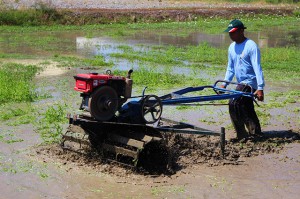Comprising about 19% of the total labor cost in rice production, there, indeed, is a pressing need to look for new ways of doing land preparation. 
The Reduced Tillage Technology (RTT) is an alternative system of land preparation for irrigated areas where plowing is not applied.
Rice stubbles, weeds, and the scattered rice straws are pressed two to three times using the hand tractor’s paddy wheels attached with riding-type leveler or by drop down-spiked tooth harrow. The pressing is done at a 5 to7-day interval.
After the final leveling, crop establishment is done either by transplanting, direct seeding using the drumseeder, or by manual broadcasting.
RTT was piloted in 2012 in Talavera and Science City of Muñoz, Nueva Ecija. After the success of its initial implementation, 14 more towns in Pangasinan, Pampanga, and Ilocos Sur were added as demonstration sites .
“Yield increase relative to using the conventional tillage method and savings generated on land preparation were the parameters used in measuring the success of the study,” said Ruben Miranda, study lead.
He explained that for 3 consecutive seasons, the average yield of the demonstration sites were relatively higher at 5.35 t/ha, 4.92 tons/ha for conventional tillage. In addition, farmers saved P3, 380.00/ha per season.
“Savings can be attributed to the faster operation time and lesser fuel consumption. In RTT, farmers can save more than 5 hours per ha in their farming operations. Savings on fuel is up to 50% or 14 l/ha lesser than in conventional tillage,” Miranda explained.
Aside from the savings and ease of land preparation, RTT also mitigates impacts of climate change.
The reduced diesel consumption and scattering of rice straws, which are usually burned by farmers, result in lesser methane and carbon dioxide emissions in the atmosphere.
Celia Abadilla, Julian Macadamia, Mark Angelo Abando, Melvin Ruiz, Laarnie Mandia, and Marvin Manalang are the study team members.
RTT is a collaborative project of PhilRice, Department of Agrarian Reform (DAR), DA-Regional Field Office in Central Luzon, and participating local government units.




